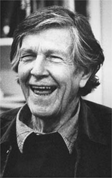THE PARAMETERS OF ALL SOUND
JOHN CAGE:
MAN, MYTH, LEGEND 
* He consistently occupied the most crucial transitional roles.
* He attracted and mentored future developers of Fluxus and Happenings in his classes at the New School for Social Research.
* He opened the doors to experimentation in Sound Arts, however Kant says that he opened so much up that he left very little to be set free.
* Filmmaker Stan Brakhage stated that only those who can encounter Cage's aesthetic net and survive (go beyond) will be the artists of our contemporary present.
* CAGE'S AESTHETIC NET: a safety device (anything could be attempted) and an obstacle (getting beyond-Cage).
BEYOND-CAGE: LOUD SOUNDS
* Cage's imperative was to listen to a sound in itself. Fluxus artists took it a step further by listening inside sounds.
THE SIZE OF SOUNDS
* Fluxus artists first tested borderline states of audibility, but these relied on the presence and absence of sound. This was basically a failed attempt to go beyond-Cage. Cage's work with small sounds had already dealt with questions of audibility in his emancipatory project. As far as he was concerned LOUD SOUNDS did not need emancipation because they could impose themselves.
DICK HIGGINS
* One of Cage's students, Higgins, said the small sounds didn't seem complete. They wanted a real physicality from sound that had not been explored.
LOUD SOUNDS, CHARACTERISTICS
1. a sonic force massively exerted
2. gives itself material substance, goes beyond the nonphysical
3. establishes an acoustic space as one where sound is felt
4. the vibrations of the sound can be felt on the whole body
5. a physical experience of sound that complements the experience of hearing with the ears and mind.
* Higgins achieved this by setting up correspondence between a line of gesture (passing a mic in front of a loud speaker) and speaker feedback - 1958 Loud Symphony.
* Example: Steve Reich's Pendulum Music (1968).
THE THEATER OF ETERNAL MUSIC
TONY CONRAD and LA MONTE YOUNG
* Known for its highly amplified concerts. Said to be "painfully loud."
* So loud, that it changed "silence" when it was finished. The ears used natural defenses to prevent hearing loss and thus, silence had changed. Kahn says this "charged silence" is a way to listen inside a sound.
* Amplification was a practical means to hear subtle aspects of sound
* Sustained tones were highly valued: slowly listening to to droning noise for extended periods of time would allow one to get inside the noise.
* Sometimes the same sound was just repeated quickly.
* Through repetition and sustained listening one could hear a new variety of sounds is what appeared to be the same sound.
DID THEY GO BEYOND-CAGE? SURE. THEY SHIFTED FROM MUSICAL COMPOSITION TO MUSICAL LISTENING. HEARING A SOUND IN ITSELF (CAGE) WAS TAKEN TO ANOTHER LEVEL BECAUSE ONCE A SOUND HAS TIME TO BE HEARD IT BECOMES PLURAL.
THE NEW BOHEMIA
* Who you are verbally is irrelevant in the presence of loud sound.
* Who you are physically also will become irrelevant because any movement in a space will move the air which affects the frequencies of the sound.
CAUTION: DO NOT TRY THIS AT HOME. MANY OF THESE ARTISTS BECAME DEAF, AND YOU WILL TOO IF YOU LISTEN TO ANY SOUNDS THAT ARE MASSIVELY AMPLIFIED.